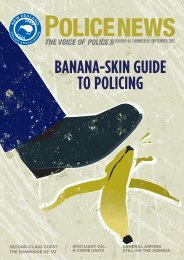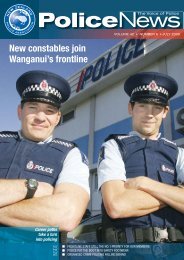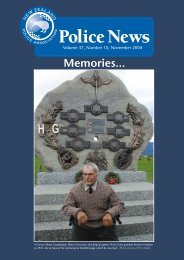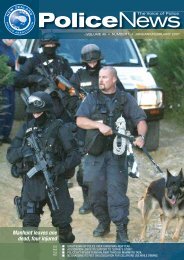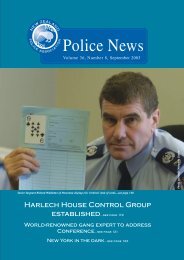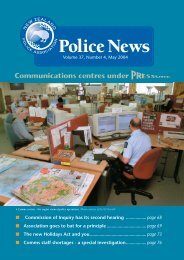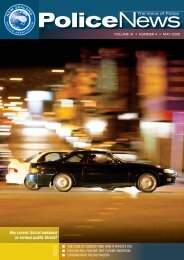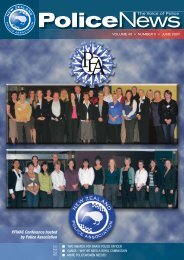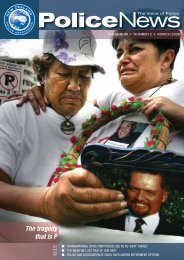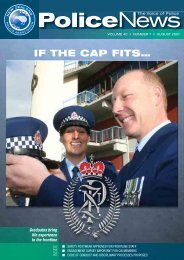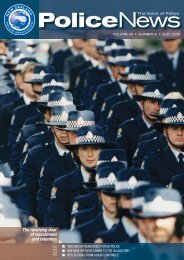Police News March 05.indd - New Zealand Police Association
Police News March 05.indd - New Zealand Police Association
Police News March 05.indd - New Zealand Police Association
Create successful ePaper yourself
Turn your PDF publications into a flip-book with our unique Google optimized e-Paper software.
<strong>March</strong> 2005<strong>Police</strong> <strong><strong>New</strong>s</strong> The Voice of <strong>Police</strong><strong>Police</strong> considering simplification of offence codesBy Steve Plowman,<strong>Police</strong> are looking into a simplificationof offence codes and standardisation ofrecording practices in order to reduce thepotential for differences in the way similaroffences are recorded and cleared andthereby reflected in crime statistics.<strong>Police</strong> are currently working with theMinistry of Justice and Australian policeto develop standards that will achievethese objectives. Implementation ofthese standards will be considered whenresources become available after themigration from LES (Law EnforcementSystem) to NIA (<strong>Police</strong> National IntelligenceApplication) is completed this year.The <strong>Police</strong> <strong>Association</strong> has fielded severalcalls, Emails and letters from police staffover the manner in which offences arecleared. Some of that correspondencerelated to an impression amongst some staffthat in some instances districts might codecrimes differently. Some officers felt this ledto a skewing of statistics in that cases werebeing noted as ‘resolved’ when no one hadbeen identified as a suspect or charged.Some alleged that custody clearances,where multiple offences can be cleared byinterviewing people in custody, even thoughno charge may be proferred against them,was misleading when all those offencescould then be recorded as resolved.District differencesWith the crime stats due out as this issuewent to press, and some doubts beingexpressed about the veracity of those stats,<strong>Police</strong> <strong><strong>New</strong>s</strong> decided to take a look at theway offences are recorded as resolved. Whatwe learned is that there are differencesbetween the way districts record and clearstats and that the accurate recording ofoffences as cleared often relies on an officer’sexperience.<strong>Police</strong> National Statistics Manager, GavinKnight (OoC, Organisational PerformanceGroup) said that <strong>Police</strong> are aware of thesedifferences and acknowledge that thereisn’t a formal and prescriptive set of rulesaround what constitutes a clearance on anationwide basis. These differences relateto the autonomy of each district and theassociated flexibility afforded to DistrictCommanders that enables them to makechoices about how to best meet theobjectives for their districts. <strong>Police</strong> operateon quite a distributed policing model,which endeavours to empower DistrictCommanders and make them individuallyresponsible for their ‘patch’. That modelworks well on many fronts but can belimited when it comes to informationmanagement.Coding correctly has its challenges. Differentcodes may be used at time of dispatch,upon investigation and resolution. Thisis because, as more information comes tohand, an incident may turn out to be differentfrom what was originally reported to <strong>Police</strong>.As each case is different, the factors that decidewhether a case is recorded as “resolved”,can be complex and can present a challengeto achieve consistently. <strong>Police</strong> are currentlylooking at how this consistency can beimproved through developing a simple set ofstandard principles that should make the taskeasier for staff.So when is a clearance a clearance?<strong>Police</strong> <strong><strong>New</strong>s</strong> posed the question to MrKnight. “Currently (and for a number ofyears now) we’ve opted for a fairly simplerule - if an offender was identified and iseither arrested, cautioned or their statisticswere entered onto a file, statistics will showthat offence as resolved. Now just to checkthat is not done inappropriately, Sergeantson Section are required to actually checkwhat their constables are putting in andsee that that is appropriate and check thatthe evidence and facts are consistent,” MrKnight said.“I have frequently seen them [Sergeants]challenging and coaching constables tomake sure that’s happening,” Mr Knightsaid. “<strong>Police</strong> audit files on a sample basisand in some districts audit every single fileand have a ‘gatekeeper’ role just to checkthat they are getting consistency across thedistrict,” he added.The real test of whether the case can berecorded as ‘solved’ is not whether <strong>Police</strong> areable to prove a case ‘beyond reasonable doubt’in a court of law, but whether the balanceof evidence clearly shows that the allegedoffender was responsible for the offence.Historical offences<strong>Police</strong> produce crime statistics yearly. Forstats to be counted they must be recordedwithin 14 days of the end of that period.Clearances of historical offences, whichare sometimes solved years after the crime- such as the Theresa Cormack murderinquiry from 1987 - never get into the crimestats as the 1987 stats are a closed book.Codifying offences can be quite complexbecause of the similarity of possible charges.The human element of interpretationis always at work. Here are a couple ofexamples: <strong>Police</strong> get a call to say therehas been a fight in the street. Units aredispatched but on arrival at the scene thereis no one there - no offenders, no witnessesi.e. no ongoing information. Thereforeit may be difficult for attending officersto determine what, if anything occurred.Subtle differences in what was reported to<strong>Police</strong> or what is discovered at the scenemay result in different classification.A good example of the complexity incorrectly classifying an offence is when avehicle is taken unlawfully. There are threecodes that can be used but each has itsown ‘test’ in terms of criminal law. That testrelates to intent. “Unlawful taking” relatesto the taking of a vehicle where the offenderdid not intend to permanently deprive theowner of the use of the vehicle (e.g. afterjoy riding). “Theft” relates to taking thevehicle with the intention of never returningit while “conversion” relates to taking thevehicle and using it for a purpose beyondwhich you were authorised to use it. (e.g.a company car used for illegal activities).<strong>Police</strong> may never know the intent of theoffender, particularly if that offender is neverapprehended, so must use evidential cues,specific to that instance, such as if and howthe vehicle was recovered. It is not an easytask but staff have to get it right.Human elementThis is where the human element ofinterpretation by the police officer handlingthe file comes into play. Mistakes can easilyoccur because the officer may not be ableto prove the ingredient of intent. If thecase goes to court, the stricter “beyondreasonable doubt” scenario then comes intoplay. For example, a charge for unlawfultaking may be proferred over theft becausepolice may not be able to prove intent.Mr Knight said <strong>Police</strong> are considering waysin which they can make things easier forstaff. “An opportunity may arise after wemigrate onto NIA (National IntelligenceApplication), which is a newer IT systemwith greater functionality than the ageingLaw Enforcement System (LES).”Mr Knight said that, although <strong>Police</strong> statisticshave been very stable over time, particularlyat a high level, <strong>Police</strong> were looking at simplerrules for stats purposes in future, which wouldenable more consistency nationwide andbetter comparability in terms of crime trendsover time.<strong>Police</strong> <strong>Association</strong> President, GregO’Connor, told <strong>Police</strong> <strong><strong>New</strong>s</strong>: “<strong>Police</strong> areundergoing a culture change in relation tocrime stats. In years gone by, districts withhigh crime got more funding and resourcescome Budget time. The culture in manydistricts was to report everything as a crimeto get more resource. The reward for lowcrime was often less funding. Now theresource is population-based so that nolonger applies. However, the culture changeto ‘less is best’, which has been imposedon District Commanders, has been slow tofilter down into the organisation, which iswhy the districts are spending so much timeand resource auditing their figures. Also,staff are naturally suspicious of the changes,as they believe they are being led out of theOffice of the Commissioner.”Various state <strong>Police</strong> jurisdictions in Australiaare currently working on developing astandardisation of rules and the <strong>New</strong><strong>Zealand</strong> <strong>Police</strong> is keen to lever whatever ofthis work is appropriate for <strong>New</strong> <strong>Zealand</strong>.36



